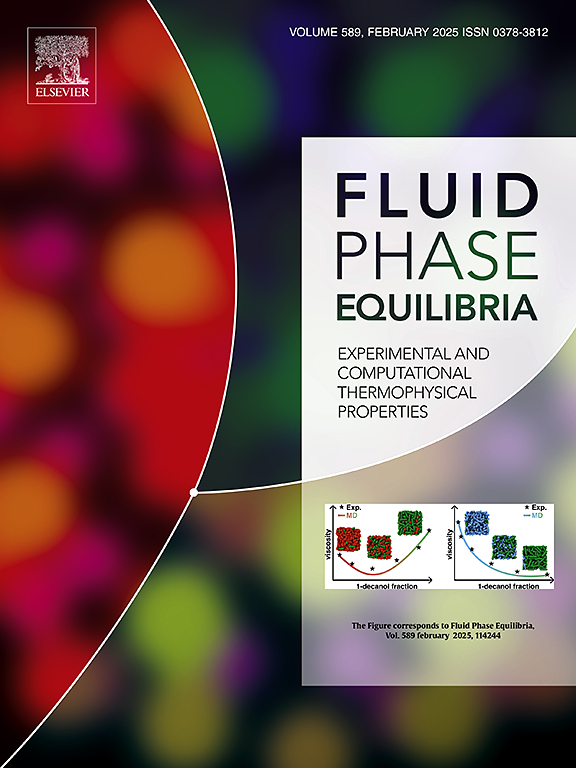Modeling flash points of biofuels using neural networks
IF 2.7
3区 工程技术
Q3 CHEMISTRY, PHYSICAL
引用次数: 0
Abstract
The search for renewable energy resources is driven by environmental hazards caused by petroleum derivatives, price fluctuations, and the unsustainability of fossil fuels. In Brazil, biodiesel and bioethanol are established renewable fuels, while butanol shows promise as an alternative fuel, requiring research into their safety and efficiency. The Flash Point (FP) is crucial for flammability assessment and safety in combustion processes, but its experimental measurement is resource-intensive. This study evaluates the capability of artificial neural networks (ANNs) to predict FP for some biofuels and their blends, using a dataset of 490 points. Notably, 24 of these points were newly acquired, while the remaining 466 were sourced from literature. A robust ANN model was trained using a 5-fold cross-validation with an 80/20 data split, incorporating average molar mass, vapor pressure natural logarithmic, and experimental method as input features. The final model, featuring three hidden layers determined through a parametric analysis, achieved a Root Mean Square Error (RMSE) of 4.22 K and a Mean Absolute Error (MAE) of 3.09 K for 98 unknown points. The model achieved satisfactory accuracy, with MAE ranging from 1.51 K to 3.63 K, and performed comparably to traditional UNIFAC thermodynamic models. These results highlight the potential of ANNs for FP prediction across diverse datasets.
用神经网络模拟生物燃料的闪点
石油衍生品、价格波动和化石燃料的不可持续性造成的环境危害推动了对可再生能源的探索。在巴西,生物柴油和生物乙醇是公认的可再生燃料,而丁醇作为替代燃料也很有希望,但需要对其安全性和效率进行研究。闪点(FP)是燃烧过程中可燃性评价和安全性评价的关键,但其实验测量耗费大量资源。本研究使用490个点的数据集,评估了人工神经网络(ann)预测一些生物燃料及其混合物FP的能力。值得注意的是,其中24点是新获得的,其余466点来自文献。将平均摩尔质量、蒸汽压自然对数和实验方法作为输入特征,采用80/20数据分割的5倍交叉验证训练了一个鲁棒的ANN模型。最终模型通过参数分析确定了三个隐藏层,对于98个未知点,其均方根误差(RMSE)为4.22 K,平均绝对误差(MAE)为3.09 K。该模型获得了令人满意的精度,MAE在1.51 ~ 3.63 K之间,与传统的UNIFAC热力学模型相当。这些结果突出了人工神经网络在不同数据集上预测FP的潜力。
本文章由计算机程序翻译,如有差异,请以英文原文为准。
求助全文
约1分钟内获得全文
求助全文
来源期刊

Fluid Phase Equilibria
工程技术-工程:化工
CiteScore
5.30
自引率
15.40%
发文量
223
审稿时长
53 days
期刊介绍:
Fluid Phase Equilibria publishes high-quality papers dealing with experimental, theoretical, and applied research related to equilibrium and transport properties of fluids, solids, and interfaces. Subjects of interest include physical/phase and chemical equilibria; equilibrium and nonequilibrium thermophysical properties; fundamental thermodynamic relations; and stability. The systems central to the journal include pure substances and mixtures of organic and inorganic materials, including polymers, biochemicals, and surfactants with sufficient characterization of composition and purity for the results to be reproduced. Alloys are of interest only when thermodynamic studies are included, purely material studies will not be considered. In all cases, authors are expected to provide physical or chemical interpretations of the results.
Experimental research can include measurements under all conditions of temperature, pressure, and composition, including critical and supercritical. Measurements are to be associated with systems and conditions of fundamental or applied interest, and may not be only a collection of routine data, such as physical property or solubility measurements at limited pressures and temperatures close to ambient, or surfactant studies focussed strictly on micellisation or micelle structure. Papers reporting common data must be accompanied by new physical insights and/or contemporary or new theory or techniques.
 求助内容:
求助内容: 应助结果提醒方式:
应助结果提醒方式:


